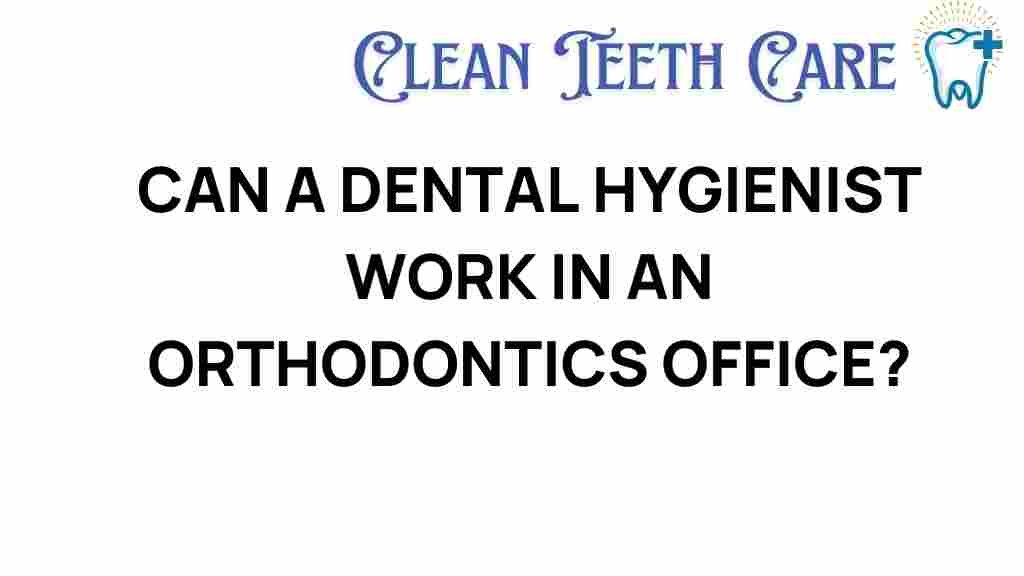Unveiling the Role of Dental Hygienists in Orthodontics
The role of a dental hygienist in the field of orthodontics is crucial for promoting oral health and enhancing dental care practices. As essential members of the dental team, dental hygienists provide valuable support in orthodontic settings, helping to ensure that patients receive the best possible care. This article explores the multifaceted role of dental hygienists in orthodontics, outlining their responsibilities, career paths, and contributions to patient care.
Understanding the Role of Dental Hygienists
Dental hygienists are trained professionals who specialize in preventive oral health care. Their primary responsibilities include:
- Conducting dental cleanings
- Applying sealants and fluoride treatments
- Educating patients on oral hygiene practices
- Taking dental radiographs (X-rays)
- Assisting dentists during procedures
In the context of orthodontics, their role expands significantly. They work closely with orthodontists to help manage patient care, particularly for those undergoing braces or other orthodontic treatments.
The Importance of Dental Care in Orthodontics
Orthodontics focuses on diagnosing, preventing, and correcting misaligned teeth and jaws. Effective dental care is vital to achieving optimal results from orthodontic treatment. Dental hygienists play a pivotal role by:
- Providing thorough cleanings to remove plaque and tartar, which can hinder orthodontic progress
- Monitoring oral health throughout the orthodontic treatment process
- Educating patients on the importance of maintaining proper hygiene while wearing braces
By supporting patients in maintaining oral health, dental hygienists help prevent complications such as cavities and gum disease that can arise during orthodontic treatment.
Career Paths for Dental Hygienists in Orthodontics
For dental hygienists, there are various career paths within the field of orthodontics. These paths may include:
- Clinical Hygienist: Working directly in orthodontic practices, providing patient care and support.
- Orthodontic Coordinator: Managing patient schedules, treatment plans, and communications between patients and the orthodontic team.
- Educator: Teaching oral health practices and the role of orthodontics in dental hygiene programs.
- Researcher: Engaging in studies that explore the impacts of orthodontic treatments on oral health.
The demand for skilled dental hygienists in orthodontics is growing, making this a promising field for those interested in pursuing a career in dentistry.
Steps Dental Hygienists Take in Orthodontic Settings
Dental hygienists follow a systematic approach to ensure comprehensive care in orthodontic offices. Here’s a step-by-step process outlining their involvement:
1. Initial Assessment
Upon patient arrival, dental hygienists conduct an initial assessment, which includes:
- Reviewing medical history
- Assessing the condition of oral hygiene
- Identifying any potential issues such as plaque buildup or gingivitis
2. Dental Cleaning
After the assessment, the hygienist performs a thorough dental cleaning, focusing on areas that are difficult to maintain with braces:
- Scaling and polishing teeth
- Removing plaque and tartar buildup
3. Patient Education
Education is a vital component of a dental hygienist’s role. They provide guidance on:
- Proper brushing and flossing techniques for braces
- Dietary recommendations to avoid damaging braces
- The importance of regular dental visits
4. Treatment Monitoring
Throughout the orthodontic treatment, dental hygienists monitor the patient’s progress:
- Documenting changes in oral health
- Communicating with the orthodontist about any concerns
5. Follow-Up Care
After the orthodontic treatment, dental hygienists continue to support patients by:
- Providing post-treatment care instructions
- Encouraging regular dental visits for retainer checks
Troubleshooting Common Issues in Orthodontic Care
Dental hygienists also play a crucial role in troubleshooting common issues that arise during orthodontic treatment. Here are some typical problems and their solutions:
1. Discomfort from Braces
Issue: Patients often experience discomfort after adjustments.
Solution: Hygienists can recommend over-the-counter pain relief and suggest soft foods to make eating easier.
2. Oral Hygiene Challenges
Issue: Maintaining hygiene can be challenging with braces.
Solution: Hygienists can demonstrate effective brushing and flossing techniques using specialized tools like orthodontic flossers and interdental brushes.
3. Loose Brackets or Wires
Issue: Patients may experience loose brackets or wires.
Solution: Hygienists can provide instructions on how to temporarily secure the bracket and advise the patient to schedule an appointment with the orthodontist.
The Impact of Dental Hygienists on Patient Care
The contributions of dental hygienists to patient care in orthodontics are significant. They help patients feel comfortable and informed throughout their treatment journey. Their role enhances the overall experience by:
- Building rapport with patients, which can reduce anxiety
- Providing personalized care tailored to each patient’s needs
- Encouraging open communication about concerns and questions
Furthermore, the presence of a dental hygienist in orthodontic practices contributes to the efficiency of the dental team, allowing orthodontists to focus on more complex procedures.
Conclusion
In conclusion, the role of a dental hygienist in orthodontics is invaluable for promoting oral health and enhancing dental care. From initial assessments to ongoing patient education and troubleshooting, dental hygienists are key players in ensuring successful orthodontic outcomes. With various career paths available within the field, aspiring dental hygienists can find fulfilling opportunities that contribute to patient care and the advancement of dentistry as a whole. Their expertise not only benefits individual patients but also supports the broader goals of maintaining healthy smiles across communities.
For more information on dental hygiene and orthodontics, feel free to visit this resource. To explore career opportunities in dental hygiene, check out this link.
This article is in the category Treatments and created by CleanTeethCare Team
